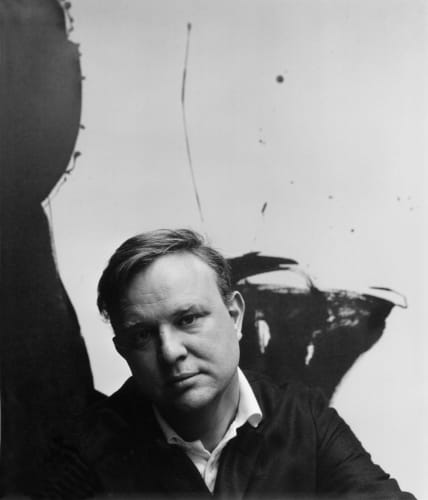American painter, Robert Motherwell was one of the founders and principle exponents of Abstract Expressionism, who was among the first American artists to cultivate accidental elements in his work. A precocious youth, Motherwell received a scholarship to study art when he was 11 years old. He preferred academic studies, however, and eventually took degrees in aesthetics from Stanford and Harvard universities.
Motherwell decided to become a serious artist only in 1941. Although he was especially influenced by the Surrealist* artists; Max Ernst, Yves Tanguy, and André Masson; he remained largely self-taught. His early work followed no single style, but already contained motifs from which much of his later art grew. He received his first one-man show in 1944 at Peggy Guggenheim's Art of This Century Gallery* in New York City. In the mid-1940s, Motherwell painted abstract figurative works that showed the influence of Surrealism*. But in 1949 he painted the first in a series of works collectively entitled "Elegy to the Spanish Republic." He painted almost 150 versions of these "Elegies" in the next three decades. These Abstract Expressionist paintings show his continuous development of a limited repertory of simple, serene, and massive forms that are applied in black paint to the picture plane in such a way that they generate a sense of slow, solemnly suggestive movement.
During the 1960s he painted in several different styles, so that such paintings as Africa (1964, 65; Baltimore Museum of Art) look like enlarged details of elegant calligraphy, while Indian Summer, #2 (1962, 64) combines the bravura brush-work typical of Abstract Expressionism with the broad areas of evenly applied color characteristic of the then-emerging Color Field* Painting style. By the end of the decade, paintings in his Open series (1967, 69), he had abandoned Abstract Expressionism in favor of the new style.
From 1958 to 1971 Motherwell was married to the American painter Helen Frankenthaler. He taught art at Hunter College (1951, 58, 1971, 72), directed the publication of the series "The Documents of Modern Art" (1944, 52), and wrote numerous essays on art and aesthetics. He was generally regarded as the most articulate spokesman for Abstract Expressionism.
